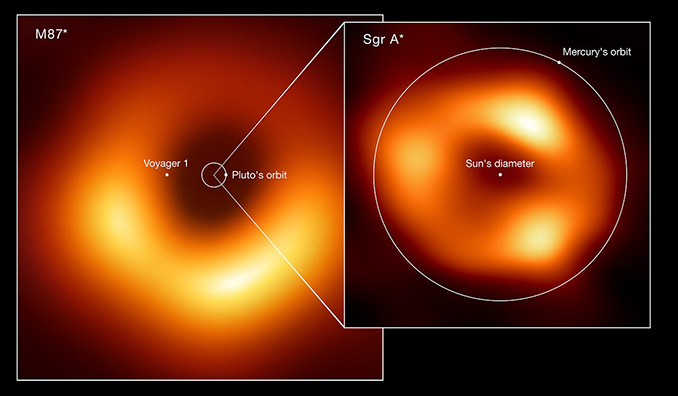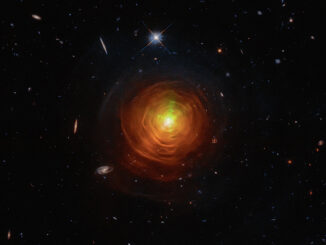
The black hole in the centre of our Milky Way Galaxy has been imaged for the first time, showing a ring of gas encircling the event horizon, beyond which no light can escape.
The stunning image is a product of the Event Horizon Telescope (EHT) – an array of eight telescopes in four continents that are able to operate in unison to achieve the sensitivity required to image the black hole in submillimetre wavelengths.
The image shows not only an accretion disc of gas swirling around the black hole, which is called Sagittarius A*, but also the ‘shadow’ of the black hole, which is the dark region in the centre of the ring.
“We were stunned by how well the size of the ring agreed with predictions from Einstein’s General theory of Relativity,” says Geoffrey Bower, who is a Project Scientist on the EHT, from the Institute of Astronomy and Astrophysics, Academia Sinica, Taipei.
For the past two decades astronomers, led by Andrea Ghez at the University of California, Los Angeles, and Reinhard Genzel of the Max Planck Institute for Extraterrestrial Physics in Germany, have been tracking stars that orbit extremely close to the black hole, one of which gets as close as 13 billion kilometres, or 90 times the distance between Earth and the Sun, to the black hole. By calculating their orbits, astronomers have been able to obtain precise measurements of the mass of Sagittarius A*, which they show to be 4.3 million times the mass of our Sun.
The size of a black hole’s event horizon is directly related to the mass of the black hole – the more massive the black hole, the larger the diameter of the event horizon. So, if the measurement of 4.3 million solar masses is correct, resulting in an event horizon that appears to be about 52 microarcseconds on the sky at our distance of 27,000 light years from the black hole, then the image of the black hole should show an event horizon of the same size. Any deviation from this would imply that there was a problem with the General Theory of Relativity.
Fortunately, the image showed an event horizon 51.8 microarcseconds across, well within the predicted error margins, and vindicating Einstein’s theory once again.
The ring, or torus, is formed from gas encircling the black hole. The Event Horizon Telescope’s previous image, of the black hole at the heart of the galaxy Messier 87 in the Virgo Cluster, also revealed a gas ring, but the amount of gas flowing onto M87’s black hole is far greater than that flowing onto Sagittarius A*, which in comparison is just a trickle. Nevertheless, the gas ring was seen to fluctuate over a matter of minutes as matter races around the black hole, the ring alive with turbulent energy.

“The gas in the vicinity of the black holes moves at the same speed — nearly as fast as light — around both Sagittarius A* and M87,” says Chi-kwan Chan of Steward Observatory at the University of Arizona. “But where gas takes days to weeks to orbit the larger black hole in M87, in the much smaller Sagittarius A* it completes an orbit in mere minutes. This means the brightness and pattern of the gas around Sagittarius A* was changing rapidly as we were observing it — a bit like trying to take a clear picture of a puppy quickly chasing its tail.”
Yet, despite over five million computer simulations that attempted to describe this activity, none could exactly describe the activity seen in the real image.
Part of the problem is that, ironically, it is harder to take a picture of the supermassive black hole on our doorstep than it is to image M87’s black hole, which is 54.5 million light years away. This is because between us and Sagittarius A* are huge amounts of gas and dust in the plane of the Milky Way, which can scatter radio waves, resulting in a blurred image. And because the accretion onto Sagittarius A* is so weak, the signal is fainter. The Event Horizon Telescope team are now working on ways to mitigate the scattering, with the intention of taking sharper images that can better show the turbulent behaviour and which can then be mapped more accurately to various theoretical models.
“Now we can study the differences between these two supermassive black holes [Sagittarius A* and M87] to gain valuable new clues about how this important process works,” says Keiichi Asada from the Institute of Astronomy and Astrophysics, Academia Sinica, Taipei. “We have images for two black holes — one at the large end and one at the small end of supermassive black holes in the Universe — so we can go a lot further in testing how gravity behaves in these extreme environments than ever before.”



